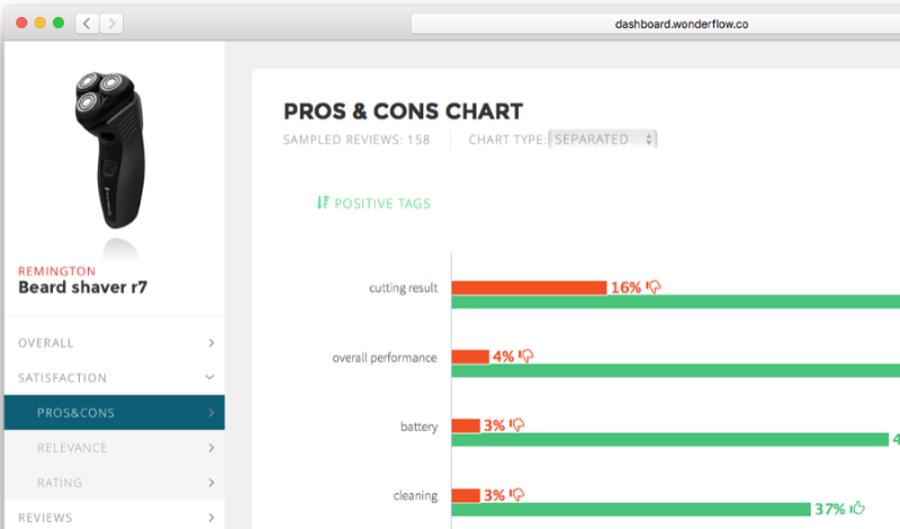Top 6 Wonderflow Alternatives & Competitors
Dec 11, 2025 - 12 minute read
Analyzing customer feedback involves understanding and evaluating customers' opinions and feedback regarding products, services, or experiences. Customer feedback analysis helps businesses understand customer satisfaction, improve their products or services, and increase customer loyalty. Customer feedback encompasses data collection, categorizing data, conducting sentiment analysis, deriving insights, and creating strategic action plans.
In this blog post, I'd like to introduce six alternatives for one of the most popular feedback analysis software, Wonderflow and talk about five things:
- Features
- Pricing
- Why I chose them as alternatives (Pros and Cons)
If you think it's time to find an alternative to Wonderflow, you're in good hands. We will start by introducing what Wonderflow is, and then we will talk about alternative tools.
Let's start!
What is Wonderflow?
Wonderflow was founded in 2014 in Amsterdam, Netherlands, by Riccardo Osti and Giovanni Gaglione. Wonderflow is a platform designed to collect, analyze, and provide valuable insights to businesses based on customer feedback. Companies can use Wonderflow to enhance customer satisfaction,improve product and service quality, and gain a competitive edge in the market.

The key features of Wonderflow include gathering customer feedback from various online platforms, such as social media, reviews, customer surveys, and other channels. The platform analyzes the collected data using techniques like emotional Analysis and sentiment analysis to understand customer sentiments and opinions. Wonderflow also helps businesses derive meaningful insights from customer feedback. These insights support product development, marketing strategies, and customer service decision-making processes.
Wonderflow Pricing
Unfortunately, Wonderflow's pricing is not available on its website. However, you can benefit from consumer feedback regarding pricing by requesting a demo and receiving pricing information within 24 hours.
Wonderflow Reviews
👍 Pros
“It is simple-to-use software that is easy to understand and provides accurate outputs. I am enjoying using Wonderflow."
👎 Cons
"Some markets are not captured well, but it would also be great to get customer feedback from niche markets."
Why Do You Need a Wonderflow Alternative?
Feature Set: Wonderflow may lack certain critical features or functionalities for specific use cases or industries. Users might seek alternatives that offer a more comprehensive feature set or specialized capabilities.
Scalability: As organizations grow or their needs change, they may require solutions that can scale accordingly. Users might explore alternatives that offer greater scalability or flexibility to accommodate changing requirements.
User Experience: Some users might find Wonderflow's user interface or overall user experience less intuitive or user-friendly than desired. Exploring alternatives could lead to finding solutions with interfaces that better suit their preferences or workflow.
Customer Support: Users who require responsive and reliable customer support may seek alternatives if they find Wonderflow's support services need more support for their needs.
TOP 6 Alternatives to Wonderflow
- Kimola (sign up free, no credit cards required!)
- Thematic
- Chattermill
- Medallia
- SentiSum
- Viable
1. Wonderflow vs. Kimola
Kimola is anqualitative researchtool for research professionals to analyze and classify customer feedback -or text data automatically. Kimola has a gallery that offers pre-built models, from SaaS Reviews Classifier to E-commerce Reviews Classifier; the Kimola team regularly publishes free machine learning models for Kimola members. At the same time, users can leverage multi-label classification technology for informed decision-making, guiding product development efforts towards optimizing the overall value proposition and ensuring customer satisfaction at every level. Moreover, users can integrate tools such as Intercom and Zendesk used by customer support teams to analyze conversational data with Kimola. Kimola's contributions don't stop there! Kimola allows the generalization of executive summaries, SWOT analyses, and FAQs based on customer reviews with its OPEN AI integration.
A List of What You Can Do with Kimola
- Analyze customer feedback without any training, instantly
- Analyze customer feedback with multi-label classification
- Conduct sentiment analysis
- Extract popular terms and topics
- Get PDF reports
- Search in customer reviews
- Create executive summary, SWOT analysis, FAQ's and other marketing materials with GPT.
Kimola Pricing
- Free plan (no credit card required)
- Basic plan: $49 / month
- Standard plan: $179 / month,
- Business plan: $359 / month
- Enterprise plans available for Larger Companies
Why I picked Kimola
Wonderflow does not offer the best UI, and its dashboard seems like it could be more user-friendly. On the other hand, Kimola provides a dashboard with a design award and is easy to onboard. Secondly, Wonderflow focuses on consumer brands and e-commerce data, but Kimola can analyze every kind of feedback, from product to brand reviews. Lastly, Wonderflow gets reviews from Amazon, but Kimola's browser extension can scrape data from 20+ sources. It can integrate with Intercom and Zendeskto analyze conversational data, voice of employee data, and customer feedback. If you're interested in a genuine customer feedback platform, Kimola is a much better alternative to Wonderflow.

2. Wonderflow vs Thematic
The idea for Thematic came about in 2015 when our founder, Alyona Medelyan, ran an NLP consultancy. Thematic is a platform used to analyze customer feedback and derive meaningful insights from it deeply. It's designed to help businesses enhance their customer experience. Thematic employs artificial intelligence and natural language processing techniques to analyze large volumes of text data. As a result, companies can automatically extract trends, key themes, sentiment analyses, and other crucial information from customer feedback.
Thematic Pricing
Thematic's starting price is $2,000. The pricing works as follows: all contracts are based on comment volume, number and type of seats, number of datasets, and the support you need. Additionally, they offer a trial period.
Why I picked Thematic
While you can't try out your dataset for free on Wonderflow, you can give Thematic a try for free after signing up for a membership. Thematic provides insights into how customer and product reviews are analyzed, whereas Wonderflow does not offer such information in advance. Thematic offers a wide range of integrations, whereas Wonderflow needs them, potentially limiting access to rich data sources as it only analyses Amazon data.
👍 Pros
Advanced Natural Language Processing (NLP): Thematic utilizes advanced NLP algorithms to analyze customer feedback data comprehensively. This enables it to extract meaningful insights and sentiment from unstructured text data more effectively than other tools.
Automated Insights: Thematic automates extracting insights from large volumes of customer feedback, saving users time and effort. Its AI-driven Analysis identifies trends, common themes, and sentiment patterns without manual input.
Integration Capabilities: For instance, you can connect and analyze data from Google Sheets with Thematic and analyze SurveyMonkey and Qualtrics surveys using Thematic.
Customizable Dashboards: Users can customize their dashboards according to their specific needs and preferences, arranging widgets, charts, and reports to visualize insights in the most actionable way.
👎 Cons
Data Privacy Concerns: Customer feedback often contains sensitive information, and companies using such platforms may have concerns about data privacy. Additional measures need to be taken to ensure data security and privacy.
Scope Limitations: Some platforms may be limited to specific data sources or formats. In such cases, users may need additional effort to integrate all data sources or convert particular data formats.
Customization Abilities: The platform's customization abilities may need to be improved for some users. These limitations pose issues, especially for users requiring complex analyses or custom reporting.
3. Wonderflow vs Chattermill
Chattermill was co-founded in 2015 by Mikhail Dubov and Dmitry Isupov at Entrepreneur First. It is a platform for analyzing customer feedback and improving the customer experience. Businesses utilize Chattermill to collect, analyze, understand, and derive meaningful insights from customer feedback.
Chattermill Pricing
Unfortunately, Chattermill doesn't provide any plans or pricing on its website.
Why did I pick Chattermill?
Although Wonderflow is simpler, it isn't more user-friendly than Chattermill. Chattermill offers better customer service. Compared to Chattermill Wonderflow, Chattermill helps us connect with our customers more deeply by directly identifying complex pain points across multiple areas based on real-time feedback, enabling every team to take action. With Chattermill, seizing the right opportunities becomes easier.
👍 Pros
Natural Language Processing (NLP) Technology: Chattermill employs advanced natural language processing technology to analyze text-based customer feedback. This allows businesses to gain deeper insights into customer sentiments, needs, and trends.
Extraction of Meaningful Insights: The platform provides advanced analytics and data visualization tools to extract meaningful insights from customer feedback. Businesses can use these insights to enhance their products, services, and customer experiences.
Integration Capabilities: The prominent integrations are Zendesk, Trustpilot, and Qualtrics.
Real-time Analysis: The platform can analyze customer feedback quickly, enabling quick responses to instant feedback.
Customizable Reporting: Chattermill offers customizable reporting options tailored to users' needs. Users can customize reports to track specific metrics, understand customer behaviours in particular segments, and monitor business performance.
👎 Cons
Pricing: Not providing information about pricing plans can be seen as a negative aspect from the customer's perspective.
Technical Support: Due to these platforms' complexity, users may encounter technical issues. Platforms that provide adequate technical support or respond promptly to user issues can positively impact user experience.
Data Limit: If you have consumer feedback below 5000 data points, working with Chattermill is impossible.
4. Wonderflow vs Medallia
Medallia was founded by Borge Hald and Amy Pressman in 2001. The company's headquarters are located in California, USA. It is a software company specializing in customer experience management. The company offers cloud-based software solutions to collect, analyze, and improve customer feedback to enhance overall customer experiences.
Medallia Pricing
While offering transparent and flexible pricing, we provide a unique experience data pricing model. Feel free to contact us for personalized customer support on our sales talk panel.
Why did I pick Medallia?
In summary, while Medallia and Wonderflow focus on customer feedback analysis and improving customer experience, their target markets,user interfaces,customization options, cost, and integration capabilities differ. Medallia differentiates itself by offering seamless integration with a wide range of systems and platforms, including CRM systems, marketing tools, and other business applications.
👍 Pros
Customer Feedback Collection and Analysis: Medallia gathers and analyzes customer feedback from various channels such as surveys, social media, emails, and customer interactions. Meaningful insights are derived from this feedback to identify strategies for enhancing the customer experience.
Automated Action Plans: Medallia can create automated action plans based on customer feedback. This enables businesses to respond to customer complaints and resolve issues quickly.
Survey and Survey Design: The platform facilitates creating customizable surveys and organizing customer satisfaction surveys. This is an essential tool for systematically collecting and analyzing customer feedback.
Integration Capabilities: Medallia offers hundreds of out-of-the-box integrations. It partners with the tools critical to your success, such as Workday, Salesforce, ServiceNow, Adobe, and more.
👎 Cons
Focus on Large-Scale Organizations: Platforms like Medallia may primarily focus on large-scale organizations, potentially including unnecessary complexity and features for small and medium-sized businesses.
5. Wonderflow vs SentiSum
SentiSum was founded in 2015 by Sharad Khandelwal and Richard D. Lee. It derives valuable insights from text data in various areas, such as customer experience, marketing analytics, brand management, and more.
SentiSum Pricing
VoC analytics for mid-market companies starts at 3.000$. Customer service representatives can assist you in finding the most suitable pricing options.
Why did I pick SentiSum?
SentiSum offers a much better interface than Wonderflow, with strong and consistent customer support notifications. From a customer perspective, SentiSum's Granular Reporting is highly valuable.
👍 Pros
Natural Language Processing (NLP) Technology: SentiSum employs advanced NLP technology to analyze text-based data. This allows companies to derive meaningful insights from customer feedback and identify trends.
Automated Insight Extraction: The platform automatically extracts insights through AI-driven analytics, enabling users to analyze large datasets quickly and effectively.
Integration Capabilities: SentiSum seamlessly integrates with thousands of platforms. Key integrations include Intercom, Zendesk, Tripadvisor, and Apple Store reviews.
Visualization and Reporting: The platform enables users to visualize data and create customizable reports. This helps companies better understand customer feedback and develop action plans.
👎 Cons
Pricing: The pricing of such platforms can sometimes be high, especially for smaller businesses or startups with limited budgets.
Learning Curve: Users may need time to familiarize themselves with the platform's interface and features, especially if they need to become more experienced with data analysis or natural language processing technologies.
Membership login: Limiting access to SentiSum only through corporate email addresses may result in suboptimal user acquisition, potentially limiting the platform's reach and effectiveness.
6. Wonderflow vs Viable’s Al
Viable is a customer support and experience platform founded in 2018 by John Kim and Haseeb Tariq. It helps businesses improve their customer support processes by collecting and analyzing customer feedback across various communication channels such as email, live chat, and social media. The platform utilizes natural language processing (NLP) technology to identify and prioritize customer requests, offers trend analysis and reporting tools, customizable automation features, and integrates with popular customer support platforms and CRM systems.
Viable Pricing
Starter: $600 /month ( Up to 2,000 data points).
Growing Companies: $1,000 /month (Up to 5,000 data points).
Why did I pick Viable?
Viable is leading the competition against Wonderflow. Viable boasts a sleek, user-friendly interface, and is also compliant with GDPR and CCPA regulations. Viable leads the competition by providing accurate, detailed, and actionable insights.
👍 Pros
Faster Responses: Viable helps businesses respond more quickly by automatically identifying and prioritizing customer requests. This improves customer satisfaction and enhances the overall customer experience.
Trend Analysis and Insights: The platform enables businesses to identify trends and patterns in customer feedback, helping them improve their products and services. This allows companies to respond more effectively to customer demands and gain a competitive edge. Generative Analysis enables obtaining deep insights quickly and effortlessly.
Ease of Integration: Data can connect seamlessly through Viable's integrations and API. For instance, Google Play Store reviews can be effortlessly turned into action through Viable. Meetings are the lifeblood of every business; Gong recordings can be leveraged to the fullest with Viable. By integrating Viable via Zapier, hidden gems in Help Scout tickets can be unearthed.
Customizable Automation: The platform allows businesses to automate repetitive tasks, such as sending automated responses to specific customer requests or prioritizing requests based on certain criteria.
Improved Quality of Customer Support: Viable improves the quality of customer support by enhancing customer support processes. This leads to more positive customer experiences and helps businesses increase customer loyalty.
👎 Cons
Cost: Depending on the pricing model, some users may find the cost of using Viable prohibitive since it starts at $600, particularly for smaller businesses or individuals with limited budgets.
Model Training: Viable seems to have a model training process that might be difficult for some clients to onboard.








